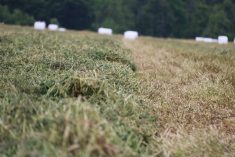KAMLOOPS, B.C. – Heavyweight cattle continue to plague the beef industry while demand is slipping.
The total number of animals continues to shrink but final carcass weights remain high for the year, producing more beef than the market wants.
Anne Dunford, senior market analyst with Canfax, said carcass weights could reach record levels this year. In 1997, steer carcasses were 763 pounds each but this year they are closer to 800 lb.
“We’re probably going to kill fewer cattle in 1998 than we did in 1997, but the problem is that 40 lb. we’re adding to steers today,” she said at the British Columbia Cattlemen’s Association convention last weekend.
Read Also

Feds propose overhaul of chronic wasting disease control program
Chronic Wasting disease control program getting updated by Canadian Food Inspection Agency with feedback encouraged from producers.
Last year she predicted a four percent reduction in beef production but it didn’t happen. Analysts are hoping to see the supply numbers come down.
Total tonnage of beef remains high because so many large cattle entered the system in the first five months of 1998. A good fall and easy winter helped put weight on the cattle.
Dunford said the heavy trend is likely to continue for some time and market prices for live cattle could drop further.
Adding to the beef supply is the large number of heifers in the slaughter mix. In 1995, only 37 percent of the heifers went for slaughter but so far this year 53 percent of them ended up in feedlots rather than the breeding herd.
Cow kill is down to about eight percent so far this year.
“We’re not selling cows off as aggressively as we were, but there’s no question we’re not replacing or retaining the heifers to start to turn this thing around to start rebuilding the herd,” said Dunford.
There may not be as many cows around but they are efficient, productive animals.
In the mid 1970s the average cow produced 425 lb. of beef. Today a cow is responsible for 605 lb.
And there are competitors sniffing about for a share of the North American meat dollar.
The American pork industry grew by about nine percent last year. Most of that increase was targeted for the Asian market. However, the Asian financial crisis halted sales and that meat stayed at home.
Poultry supplies continue to increase by about four percent each year.
“Even if we do drop our production over the next couple of years … the problem is there’s going to be more pork and more poultry. The competition is going to be fierce,” she said.
All that extra meat on the market affects prices.
“Our biggest limiting factor on where feeder and calf prices could go would have to be the competitive meat situation,” she said.
Canada will produce more than eight billion lb. of beef, pork and chicken combined this year.
Beef accounts for more than three billion of that production and is worth about $2.4 billion. National consumption is about 2.2 billion lb. of beef with the rest exported.















